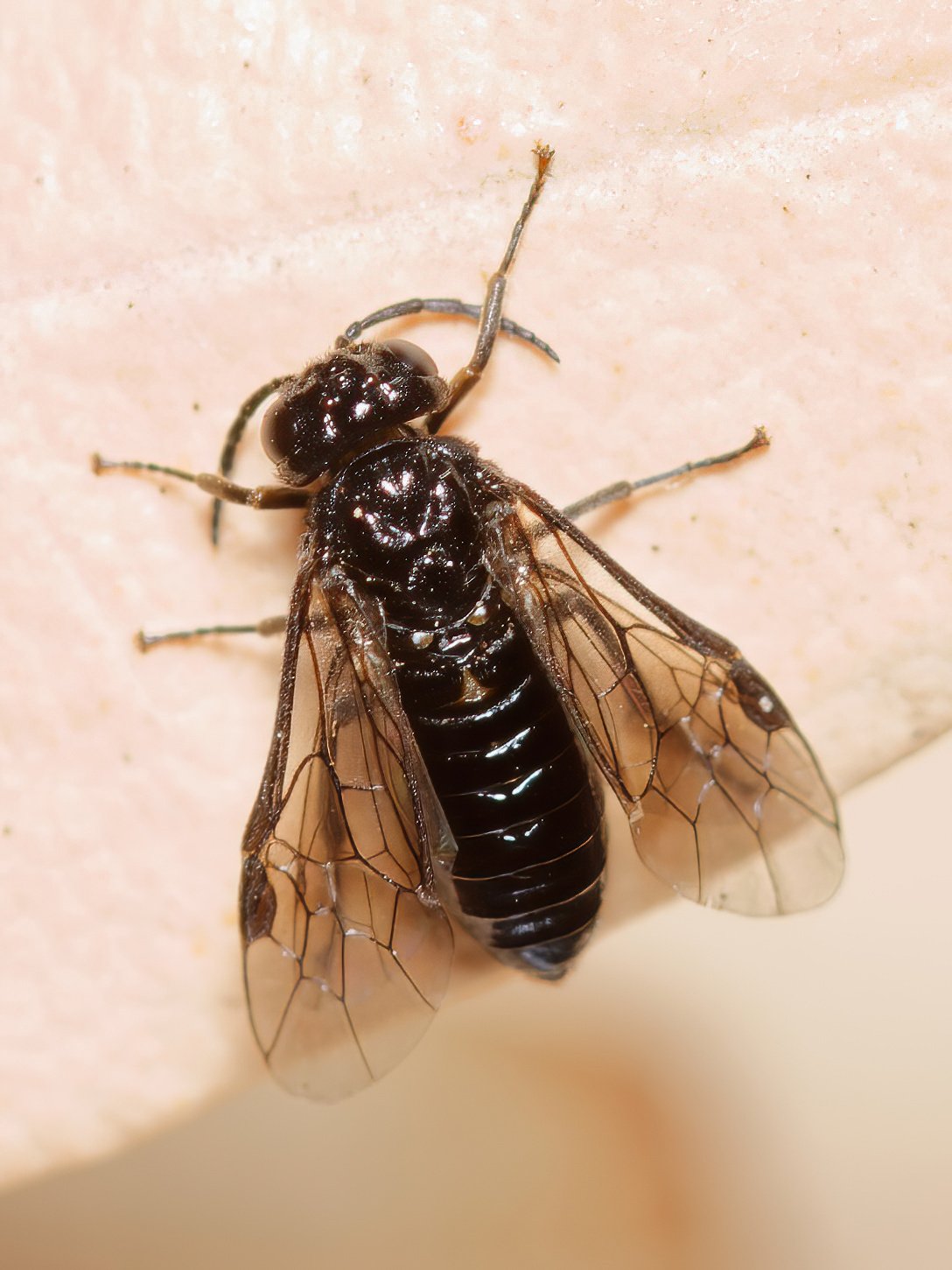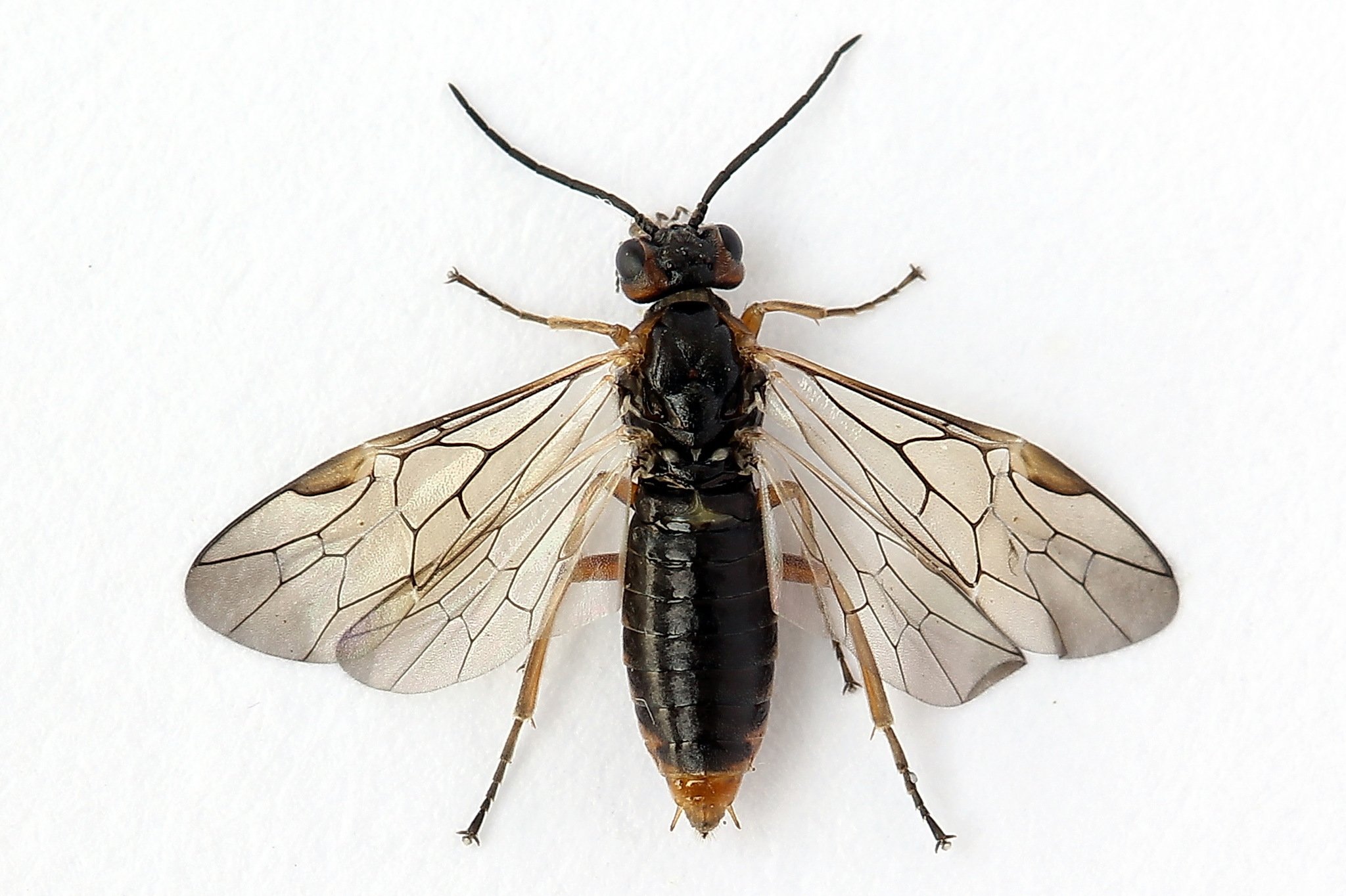Tenthredinidae - native and introduced

Image above courtesy of Roman Soroka (iNaturalist observation) CC-BY-NC
Workbook
Note: This is a “work in progress”. Changes may be made as I discover additional relevant information.
Identification of native and introduced species in family Tenthredinidae
This page is designed to aid identification of Australian Tenthredinidae sawflies, of which there are 10 species distributed across 4 different subfamilies - Allantinae, Blennocampinae, Nematinae and Selandriinae.
Only two of these sawflies - Cheilophleps xantha and Neostromboceros teres - are Australian natives, with the remainder being introduced. A second, undescribed species of Cheilophleps has been reported, but is known only from a single specimen collected in north Queensland (Naumann et al., 2002).
Another tenthredinid, Senoclidia purpurata (synonomised with Senoclidia furva by Schmidt and Smith, 2009) is only known from two specimens collected over 100 years ago at Darwin, NT and Nelson, North Queensland. As it has not been sighted since I have not considered it further.
Native species
Subfamily Blennocampinae
Cheilophleps xantha Benson
Following description from Benson (1938) and Naumann et al. (2002)
male and female:
length 7.5mm
head and thorax black with following parts cream-yellow – labrum, posterior margin of pronotum, dorsal half of mesepisternum
legs yellowish-white (except apex of tibia and tarsi of front legs, and most of tibiae and tarsi of middle and hind legs, which are brownish); coxae and femora of hind and middle legs are more yellow than front legs
abdomen yellow except for the apex from segment 8
wings slightly and evenly infuscate yellow; stigma and venation black
antenna filiform, 9 segmented, about 1.5x as long as breadth of head; segment 3 almost as long as segments 4+5
hind basitarsus longer than three following tarsal segments together, almost as long as following tarsal segments
anal cell in fore wing crossed by a short oblique vein rather than being constricted; one closed discoidal cell in female
Reported locations: Bulga, East Dorrigo, NSW
Subfamily Selandriinae
Neostromboceros teres Schmidt
Neostromboceros is a large genus found in southeastern Asia from Japan through to Papua New Guinea. This new species has been found at several locations in far north Queensland (Schmidt and Smith, 2009). It is the first Australian representative of the subfamily Selandriinae.
Description:
female:
length 7.5mm
antenna with scape, pedicel and basal half of flagellum black, apical half white; filiform, length 2.5x head width, longer than head and thorax together
head and mouthparts black; apex of mandible reddish brown
eyes large
thorax black with pronotonum (apart from black anterior margin), upper 2/3 of mesepisternum and mesoscutellum white
legs white with coxae, trochanters, narrow ring at extreme base of femur, narrow ring at apices of tibiae and tarsi black; vein Rs absent, thus with 3 cubital cells
abdomen black
wings lightly, uniformly infuscated; veins and stigma black
male:
similar to female, except as follows:
length 6.5mm
white spot laterally on each side of mesoscutal midlobe
scutellum black
Introduced species
All of the introduced sawfly species are regarded as pests as they damage a number of plants of agricultural or ornamental importance, including willows, blackberries, raspberries, pears and cherries.
For this reason, a good deal is known about the life cycles and effects on the larval food plants of several of these species. I will focus here on distinguishing the adults of these introduced species from Australian sawflies in other families.
Note that there have been taxonomic changes in several of these species. The previous genus name follows the current name in parentheses.
Subfamily Nematinae
Euura (Amauronematus) viduata (Zetterstedt) (willow bud sawfly)
This species is widely distributed in the northern hemisphere, from north-western Europe to Asia, Siberia and North America. It was first detected in 1992 at Batehaven on the south coast of NSW (Naumann, 2002).
The larvae of this species feed on weeping willow, Salix babylonica. Early stages live inside bud galls made by the ovipositing female. Late instar larvae are free living.
The following description is from Naumann (2002) and Benson (1958).
head evenly convex between antenna in lateral view and whole face very long and flat; inner orbits scarcely convex and very deeply depressed outside antennal sockets; frons weakly produced
antennae often black and shorter than costa plus stigma of fore wing
mouthparts often elongated, with maxillary palp short; clypeus pale coloured (yellow or orange)
legs predominantly dark coloured (brown); hind tibial spurs of almost equal length, scarcely longer than apical width of hind tibia
Note that many species in the huge Euura genus (~650 spp!) probably share these same features. Indeed, many Euura species are virtually indistinguishable at a gross morphological level and can only be separated by examination of the male penis valve - a method not applicable to Australian species as only females are known here.
Euura (Pontania) proxima (Lepeletier) (willow redgall sawfly)
This Northern Hemisphere species was first reported from Tasmania in 1994 and causes bean-shaped galls on the leaves of willows - images below from Patrice Baxter iNaturalist observation CC-BY-NC
The following description of the adult sawfly is based on the key in Naumann (2002).
interantennal and adorbital areas distinctly produced (figs. 11, 12 below)
frons produced (fig. 12 below)
legs predominantly pale coloured (orange, yellow or white with minor brown or black markings)
clypeus dark coloured (brown or black)
anal cell of forewing pedunculate, radial cell not divided by cross-vein (fig. 3 below)
Euura respondens (Förster, 1854) (willow sawfly)
This is another invasive Western Palaearctic species, which has been introduced to New Zealand and Australia. It is now present in ACT, NSW, eastern South Australia, Victoria and Tasmania. Like the other Euura species, its larvae defoliate willow trees.
Prous et al (2021) have shown that E. respondens is synonymous with Nematus oligospilus. Department Primary Industries Victoria has published a comprehensive report on the spread of this species in Australia and its impact on the larval food plant, the willow Salix spp.
The following images of the adult female and larva of E. respondens are from New Zealand. Images from the DPI Victoria report show that this species has the same appearance in Australia.
Schmidt and Smith (2009) state that this is a medium sized sawfly, about 6-7mm in length. They note that Nematinae in Australia are almost entirely black - making separation of this yellow species from other members of the subfamily straightforward.
Cladius (Priophorus) brullei (Dahlbom) (raspberry sawfly)
This Holarctic species was accidentally introduced to Australia and New Zealand. It was first recorded in Tasmania in 1959 but is now found in southern NSW, ACT and Victoria. The larvae feed on the leaves of various species of Rubus (raspberry, blackberry, youngberry, loganberry).
The following panel shows images of the adults and larvae in Australia and overseas.
Description:
head, thorax and abdomen all black
smoky hyaline wings; venation, costa and stigma black; radial cell not divided by cross-vein 2r-rs; anal cell constricted medially.
legs pale yellow with the basal 3/4 of all femora and the apex of hind tibia and basitarsus black.
antennae black, 2.5x the width of the head.
Click here to see Research Grade iNaturalist observations of Cladius brullei from Australia
Subfamily Allantinae
Caliroa cerasi Linnaeus (pear and cherry slug)
This species is found throughout the Northern Hemisphere and was accidentally introduced to Australia and many other countries in the Southern Hemisphere. It was first recorded in Tasmania in 1889 and is now widespread across southern Australia (Naumann et al., 2002).
The easily identified larva (see image below) feeds on the upper surface of leaves of various species of Prunus (cherry, pear, almond and plum), Pyrus (pear) and Cydonia (quince), causing considerable economic damage.
The adult is less distinctive, looking like several other introduced tenthredinids with an all black body, dark brown/black legs and hyaline wings with dark brown/black venation, stigma and costa. The black antennae are 1.3x the width of the head.
Click here to see Research Grade observations of Caliroa cerasi from Australia
Ametastegia glabrata (Fallén) (dock sawfly)
This is another widespread Northern Hemisphere tenthredinid species, first recorded in Australia at Silvan, NE of Melbourne in 1993 (Malipatil et al., 1995). The larva feeds on a range of herbaceous plants, including Rumex, Polygonum, Rheum and Chenopodium.
While they do little damage to the host plant, the larvae bore into the stems or fruit of nearby apples, raspberry canes and cherry twigs to pupate.
Malipatil et al (1995) state that “the slender, cylindrical larvae are pale green with a white band running along the lower sides of the entire length of the body.”
The adults are distinctive, with black antennae, head, thorax and narrow abdomen with all orange legs apart from black hind tarsi. Wings are smoky hyaline, more strongly so apically. Costa, stigma and venation are black.
Click here to see Research Grade observations of Ametastegia glabrata from Australia.
References:
Benson, R.B. (1938) “Sawflies of the family Tenthredinidae in Australia, with the description of a new genus and species (Hymenoptera, Symphyta)” Annals and Magazine of Natural History 2:8, 236-239
Benson, R.B. (1958) “Handbooks for the Identification of British Insects” Vol. VI, Part 2(c) Royal Entomological Society of London. London
Department of Primary Industries Victoria (2006) “Willow Sawfly (Nematus oligospilus) in Victoria - Status Report, July 2006” link to download pdf
Malipatil, M.B., I.D. Naumann & D.G. Williams (1995) “First record of Dock Sawfly Ametastegia glabrata (Fallén) in Australia (Hymenoptera: Tenthredinidae)” J. Aust. Ent. Soc. 34: 95-96
Naumann, I.D., M.A. Williams & S. Schmidt (2002) “Synopsis of the Tenthredinidae (Hymenoptera) in Australia, including two newly recorded, introduced sawfly species associated with willows (Salix spp.)” Australian Journal of Entomology 41: 1-6
Prous, M., A. Liston, A. & Mutanen, M. (2021) “Revision of the West Palaearctic Euura bergmanni and oligospila groups (Hymenoptera, Tenthredinidae).” Journal of Hymenoptera Research 84: 187-269
Schmidt, S. & D.R. Smith (2009) “Selandriinae, a subfamily of Tenthredinidae new to Australia, and a review of other Australian Tenthredinidae (Hymenoptera: Symphyta)” Australian Journal of Entomology 48: 305-309
This is a workbook page … a part of our website where we record the observations and references used in making species identifications. The notes will not necessarily be complete. They are a record for our own use, but we are happy to share this information with others.





























